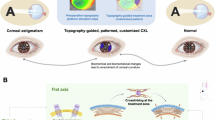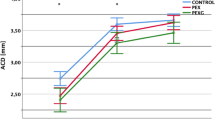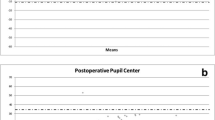Abstract
Purpose
To investigate intraoperative anterior segment optical coherence tomography (AS-OCT) to compare pachymetry changes between two methods (group 1: speculum-on, group 2: speculum-off during riboflavin instillation stage) during corneal cross-linking /CXL) (9 mW/cm2 for 10 min) in keratoconic patients.
Methods
In this interventional case series, 11 eyes (11 patients) in group 1 and 14 eyes (14 patients) in group 2 were enrolled. Pachymetry measurements by spectral domain OCT was performed at baseline, after epithelial removal, after 30 min of imbibition with riboflavin, and after UV irradiation. Repeated measures analysis of variance was used to compare the trend of changes in different stages of the procedure within and between two groups.
Results
The corneal thinnest pachymerty (CTP) at baseline, after epithelial removal, 30 min of riboflavin instillation, and irradiation was 469.8±26.5, 438.0±27.1, 354.3±28.4, 367.1±31.8 microns in group 1 and 463.2±25.1, 438.0±27.1, 421.6±54.0, 386.9±34.0 microns in group 2, respectively. Group 1 showed a significantly greater decrease in the corneal pachymetry (P<0.001) during riboflavin instillation, while in group 2 a greater decrease in CTP was observed during the UV irradiation phase (P=0.002).
Conclusions
Using the intraoperative OCT, the speculum-off group had a more stable corneal pachymetry during riboflavin instillation time. Despite this, the effect was not lasting throughout the procedure; significant changes were noted in the corneal pachymetry at the end of operation in both groups; further highlighting the limitations imposed by corneal stromal shrinkage using isotonic dextran containing riboflavin solution for CXL.
Similar content being viewed by others
Log in or create a free account to read this content
Gain free access to this article, as well as selected content from this journal and more on nature.com
or
References
Rabinowitz YS . Keratoconus. Surv Ophthalmol 1998; 42 (4): 297–319.
Wollensak G, Spoerl E, Seiler T . Riboflavin/ultraviolet-A-induced collagen crosslinking for the treatment of keratoconus. Am J Ophthalmol 2003; 135 (5): 620–627.
Wollensak G . Crosslinking treatment of progressive keratoconus: new hope. Curr Opin Ophthalmol 2006; 17 (4): 356–360.
Theuring A, Spoerl E, Pillunat L, Raiskup F . [Corneal collagen cross-linking with riboflavin and ultraviolet-A light in progressive keratoconus: Results after 10-year follow-up]. Ophthalmologe 2015; 112 (2): 140–147.
Hashemi H, Seyedian MA, Miraftab M, Fotouhi A, Asgari S . Corneal collagen cross-linking with riboflavin and ultraviolet A irradiation for keratoconus: long-term results. Ophthalmology 2013; 120 (8): 1515–1520.
Spoerl E, Mrochen M, Sliney D, Trokel S, Seiler T . Safety of UVA-riboflavin cross-linking of the cornea. Cornea 2007; 26 (4): 385–389.
Mazzotta C, Caragiuli S . Intraoperative corneal thickness measurement by optical coherence tomography in keratoconic patients undergoing corneal collagen cross-linking. Am J Ophthalmol 2014; 157 (6): 1156–1162.
Kymionis GD, Kounis GA, Portaliou DM, Grentzelos MA, Karavitaki AE, Coskunseven E et al. Intraoperative pachymetric measurements during corneal collagen cross-linking with riboflavin and ultraviolet A irradiation. Ophthalmology 2009; 116 (12): 2336–2339.
Schmidinger G, Pachala M, Prager F . Pachymetry changes during corneal crosslinking: effect of closed eyelids and hypotonic riboflavin solution. J Cataract Refract Surg 2013; 39 (8): 1179–1183.
Soeters N, Van Bussel E, Van der Valk R, Van der Lelij A, Tahzib NG . Effect of the eyelid speculum on pachymetry during corneal collagen crosslinking in keratoconus patients. J Cataract Refract Surg 2014; 40 (4): 575–581.
Chow VW, Biswas S, Yu M, Wong VW, Jhanji V . Intraoperative pachymetry using spectral-domain optical coherence tomography during accelerated corneal collagen crosslinking. Biomed Res Int 2013; 2013: 848363.
Li N, Peng X, Fan Z, Pang X, Xia Y . Variation in central corneal thickness during open-or closed-eye riboflavin instillation for corneal collagen cross-linking. Eye Sci 2013; 28 (4): 185–189.
Hafezi F, Mrochen M, Iseli HP, Seiler T . Collagen crosslinking with ultraviolet-A and hypoosmolar riboflavin solution in thin corneas. J Cataract Refract Surg 2009; 35 (4): 621–624.
Aurich H, Wirbelauer C, Jaroszewski J, Hartmann C, Pham DT . Continuous measurement of corneal dehydration with online optical coherence pachymetry. Cornea 2006; 25 (2): 182–184.
Mazzotta C, Traversi C, Caragiuli S, Rechichi M . Pulsed vs continuous light accelerated corneal collagen crosslinking: in vivo qualitative investigation by confocal microscopy and corneal OCT. Eye 2014; 28 (10): 1179–1183.
Mazzotta C, Baiocchi S, Caporossi T, Caragiuli S, Paradiso AL, Caporossi A . Riboflavin 0.1%(VibeX) for the treatment of keratoconus. Expert Opin Orphan Drugs 2013; 1: 235–240.
Oltulu R, Satirtav G, Donbaloglu M, Kerimoglu H, Özkagnici A, Karaibrahimoglu A . Intraoperative corneal thickness monitoring during corneal collagen cross-linking with isotonic riboflavin solution with and without dextran. Cornea 2014; 33 (11): 1164–1167.
Çınar Y, Cingü AK, Şahin A, Türkcü FM, Yüksel H, Caca I . Intraoperative corneal thickness measurements during corneal collagen cross-linking with isotonic riboflavin solution without dextran in corneal ectasia. Cutan Ocular Toxicol 2014; 33 (1): 28–31.
Rechichi M, Mazzotta C, Daya S, Mencucci R, Lanza M, Meduri A, Intraoperative OCT . Pachymetry in patients undergoing dextran-free riboflavin UVA accelerated corneal collagen crosslinking. Curr Eye Res 2016; 41 (10): 1310–1315.
Jacob S, Kumar DA, Agarwal A, Basu S, Sinha P, Agarwal A . Contact lens-assisted collagen cross-linking (CACXL): a new technique for cross-linking thin corneas. J Refract Surg 2014; 30 (6): 366–372.
Author information
Authors and Affiliations
Corresponding author
Ethics declarations
Competing interests
The authors declare no competing financial interest.
Rights and permissions
About this article
Cite this article
Ghaffari, R., Mortazavi, M., Anvari, P. et al. Intraoperative optical coherence tomography to evaluate the effect of the eyelid speculum on corneal pachymetry during accelerated corneal cross-linking (9 mW/cm2). Eye 32, 579–585 (2018). https://doi.org/10.1038/eye.2017.243
Received:
Accepted:
Published:
Issue date:
DOI: https://doi.org/10.1038/eye.2017.243



